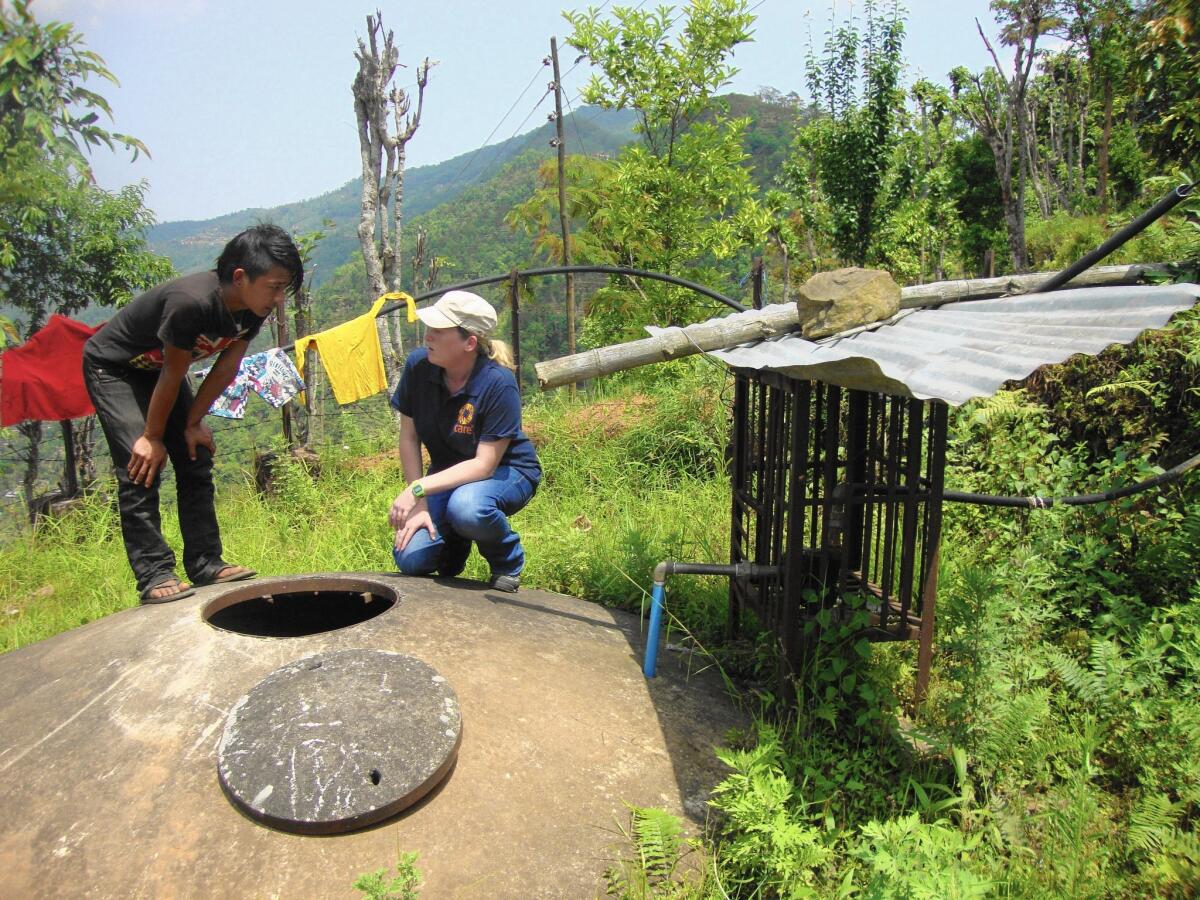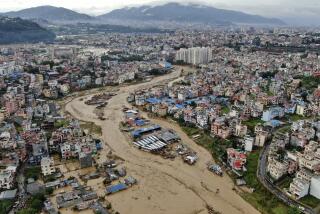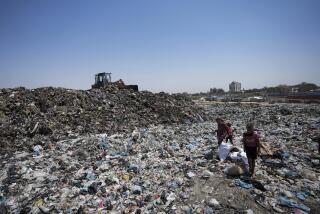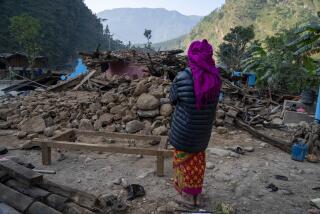Nepal sanitation efforts suffer after quake

- Share via
Reporting from Paslang, Nepal — Sanitation specialist Tess Gough arrived in this earthquake-ravaged town with an uncomfortable question to ask.
“It’s about toilets,” she said.
As in many towns and villages in Nepal, most of the brick homes in Paslang were reduced to rubble by the 7.8 earthquake that struck April 25. Water was still flowing from communal taps, but no one had checked whether the water system had been damaged. And it wasn’t clear where people were going to the bathroom.
“We had a toilet in each house before,” Bikash Ranamayar, 20, told Gough. “But most have been destroyed.”
Before the quake, Nepal had made great strides in building toilets and persuading people to stop going to the bathroom outdoors, one of the leading causes of cholera and other diseases. But now at least 2.8 million are displaced, many holed up in tents in more than 16 camps, unable or unwilling to return to quake-damaged homes.
Experts warn there could be another outbreak of diseases like they saw in Haiti after the earthquake there five years ago.
“There was a big campaign in Nepal, ‘One house, one toilet,’” said Gough, who works with the Atlanta-based nonprofit CARE. But before those public health campaigns in recent years, she added, “a lot of people didn’t have toilets, so if they get damaged, they could go back to that.”
During her visit last week to Paslang, about 140 miles west of Katmandu, Gough asked Ranamayar to show her the water system, from tap to source.
They walked uphill through the village, past the ruins of several of its 46 homes, to a communal tap where a woman was filling brass jugs.
“This is what I’m worried about,” Gough said.
They came to a second tap where an elderly woman was bathing.
“We do bathing cabins too,” Gough noted, citing projects that provide both sanitation and privacy.
They climbed past the tap and followed the pipe that feeds it uphill to an underground holding tank. The tank’s top was open, and they could hear water rushing below.
“Where does the water come from?” Gough asked.
Ranamayar, an electrical engineering student, pointed to a hill opposite.
“And where is the pipe?”
He pointed again. Gough checked the pipe. It appeared to be in good condition.
Then she pressed him about toilets.
“Are people sharing?” she asked.
Yes, Ranamayar said. He has been living in a tent, using a neighbor’s bathroom.
“Do they go in the field?” she asked.
No, he said. But he didn’t sound totally sure.
Building toilets can be expensive, Gough said: $100 for a structure with flimsy woven walls, up to $500 for a brick privy.
Ranamayar said Paslang residents had been working on constructing more bathrooms when the quake hit.
“Maybe we can work on the toilets so people don’t have to share,” Gough said.
She left Paslang that day convinced that Nepal now faces two challenges: restoring sanitation in areas that have been destroyed and maintaining it in the temporary camps.
The largest camp is at the Tundikhel parade grounds in central Katmandu, the capital. Although it has shrunk from 12,000 to several thousand residents, sanitation is still a concern there and at other camps around the capital, experts said.
Bina Niraulla, 34, has been staying at the camp with her four small sons since their home was damaged in the quake.
“The water facility is good,” she said as she waited in line for water being trucked in by the Nepalese army this week. “The problem is the toilets. Too many people are using the toilets. It’s dirty and people need to wait in the line, so a few are using the field.”
That would be the same field where babies crawl, children pile rocks and dogs roam.
“There are functioning toilets, but there’s three for hundreds of people and it’s not well lit,” leading to safety concerns, said Carolynne Wheeler, spokeswoman for the Katmandu office of international nonprofit WaterAid, which works to improve sanitation.
Sanitation experts are concerned about the spread of disease in the camps but also in more rural areas such as Lalitpur, a town about three miles south of the capital where they have already heard about small diarrhea outbreaks, Wheeler said.
“We must remain vigilant in our efforts to prevent and control communicable disease outbreaks,” said Dr. Roderico Ofrin, head of emergency response for the World Health Organization, which has been surveying and coordinating Nepal’s medical services since the quake.
Health teams have been deployed to Gorkha and Sindhuli districts to the west of the capital to respond to reports of influenza and diarrhea, according to the latest United Nations Office for the Coordination of Humanitarian Affairs situation report.
“We want to stop it before it spreads because it can spread very quickly,” Wheeler said of contagious disease Thursday as she distributed 800 hygiene kits of soap, toothpaste, detergent, cups, buckets and other essentials in Kavre, about 60 miles southeast of the capital.
“We’re seeing a lot of families that have lost everything and if you don’t have enough soap to clean yourself or your child after you’ve gone to the bathroom, that’s a risk,” she said.
Wheeler visited a village this week where residents ran out of buckets and were hauling water in dirty plastic bottles.
“It’s a very real concern,” she said of diseases such as cholera. “There are still people in very serious circumstances and monsoon season is around the corner.”
Dr. Baburam Marasini, director of the government’s epidemiology and disease control division, said his staff has surveyed and found no outbreaks so far.
The government has been promoting hand-washing with soap and urging residents to use bathrooms, he said. Wheeler said public health officials were preparing to launch a public awareness radio campaign.
“The sad thing is Nepal was really doing well and making progress in moving people toward latrines,” she said.
The next day, she and a group from WaterAid planned to visit Lalitpur, which a month ago was declared free of open defecation.
After the earthquake, the latrines there were still standing. But many homes were not, she said, which will is likely to pose a challenge to the heath of those who remain.
Twitter: @mollyhf
More to Read
Sign up for Essential California
The most important California stories and recommendations in your inbox every morning.
You may occasionally receive promotional content from the Los Angeles Times.











